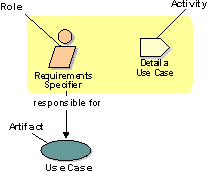The most central concept in a unified process for a project is that of a role. A role defines the behavior and responsibilities of an individual, or a set of individuals working together as a team, within the context of a software engineering organization. A role is an abstract definition of a set of activities performed and artifacts owned by the individual. These responsibilities are their activities and their artifacts. The artifacts are documents produced during the life-cycle of the project and given to the customer as a delivery. In this study the Project Managers role, activities and artifacts will be shown and examined in detail. Associated with each Role is the Workflow graphic of the individual. These are displayed in the Workflow graphic. Roles are typically realized by an individual, or a set of individuals, working together as a team. A project team member typically fulfills many different roles. While most roles are realized by people within the organization, people outside of the development organization play an important role: for example, that of the stakeholder of the project or product being developed.
Note that roles are not individuals; instead they describe how individuals behave in the project life-cycle and what responsibilities these individuals have. Individual members of the software development organization will wear different hats, or perform different roles. The mapping from individual to role, performed by the project manager when planning and staffing the project allows different individuals to act as several different roles, and for a role to be played by several individuals.

A Workflow graphic of its role, activities and artifacts
Roles have a set of cohesive activities that they perform. These activities are closely related and functionally coupled, and are best performed by the same individual.
Activities are closely related to Artifacts. Artifacts provide the input and output for the activities, and the mechanism by which information is communicated between Activities. Different Roles will be responsible for the Artifacts and may share the update process and configuration management of the artifacts.
Introduction to Disciplines
A discipline shows the flow of all activities the Project Manager will go through to produce a particular set of artifacts. The disciplines are described at an overview level or a summary of all roles, activities, and artifacts that are involved. Also will be shown, at a more detailed level is how roles collaborate, and how they use and produce artifacts. The steps at this detailed level are called "workflow details".
Descriptions of Disciplines for Project Management
The Project Management discipline is described by the follows:
All Project Disciplines
- Business Modeling
- Requirements
- Analysis & Design
- Implementation
- Test
- Deployment
- Environment
- Project Management
- Configuration & Change Management